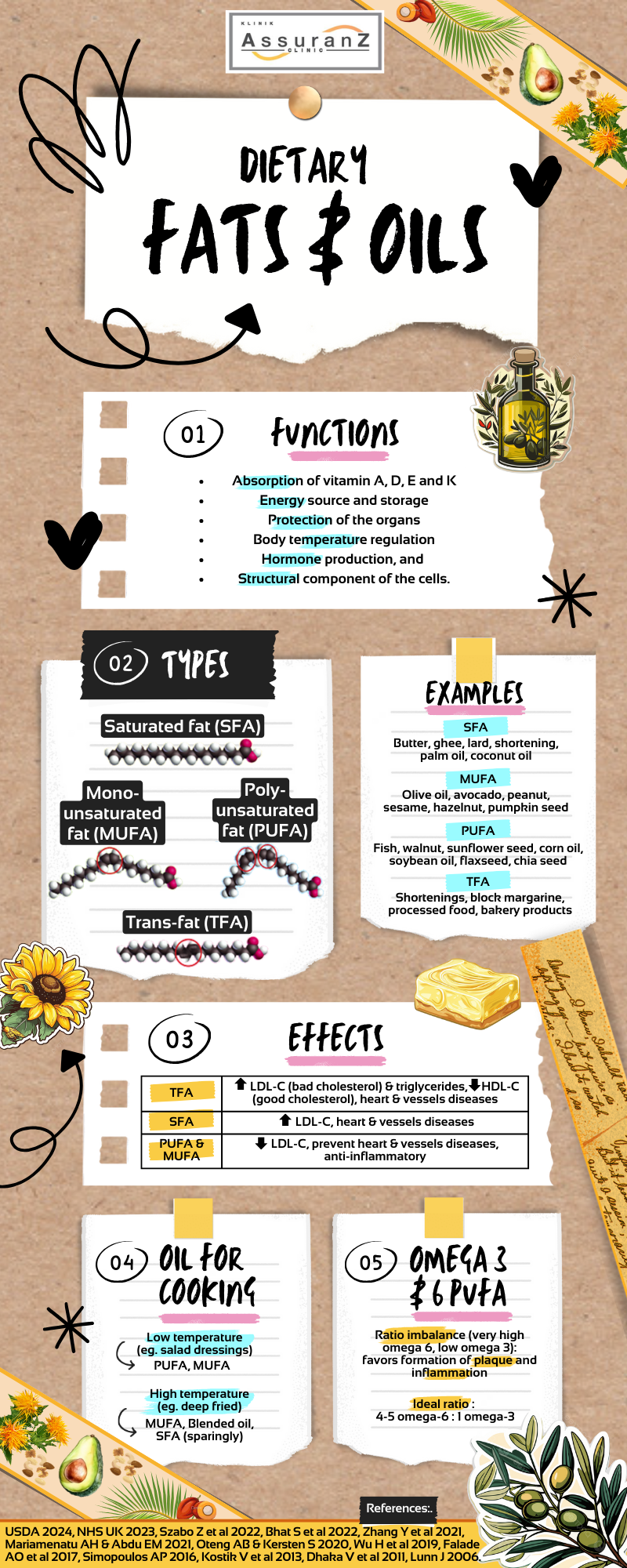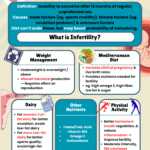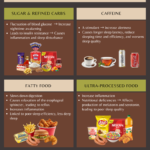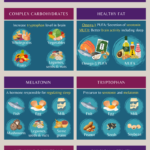Dietary fat, one of the macronutrients that we consume alongside carbohydrate and protein, is an important component of a healthy and balanced diet. Among the functions of fat include absorption of vitamin A, D, E and K, energy source and storage, protection of the organs, body temperature regulation, hormone production, and structural component of the cells. However, the amount and type of fat consumed plays a crucial role in determining whether a diet is healthy or otherwise. Fats are categorized as saturated or unsaturated based on the type of bond between the fatty acid molecules.
膳食脂肪是人体继碳水化合物和蛋白质所需摄入的三大营养素之一。它是健康和均衡饮食的重要组成部分。脂肪的主要功能包括帮助吸收维生素A、D、E和K,提供和储存能量、保护器官、调节体温、促进激素的合成及作为细胞结构的基本成分。然而,脂肪的摄入量和类型在决定饮食是否健康起着至关重要的作用。根据脂肪酸分子之间键的不同,脂肪可分为饱和脂肪及不饱和脂肪。
Saturated fatty acid (SFA) / 饱和脂肪酸
- Mainly solid at room temperature. This is due to the structure carbon-carbon single bonds, forming straight molecules that can easily stack with minimal space in between the molecules.
在室温下大多为固体。其原因在于碳-碳单键的结构,使得脂肪酸分子呈现直线排列,并能够紧密堆叠,分子间的空间较小。
- Examples: Butter, lard, ghee, shortenings, coconut oil, palm oil
例子:黄油、猪油、酥油、起酥油、椰子油、棕榈油
Unsaturated fatty acid / 不饱和脂肪
- Mostly liquid at room temperature. This is due to the carbon-carbon double bond(s), forming bent molecules with spaces in between. There are two main types, which are mono-unsaturated and poly-unsaturated fatty acids.
在室温下大多为液体。这是由于碳-碳双键的存在,使得脂肪酸分子呈弯曲状,分子之间有较大的间隙。不饱和脂肪主要分为单不饱和脂肪酸及多不饱和脂肪酸两类。
- Mono-unsaturated fatty acid (MUFA): One carbon-carbon double bond in cis configuration. Examples: Olive oil, avocado, hazelnut, peanut, pumpkin seed, sesame seed, safflower seed
单不饱和脂肪酸(MUFA):含有一个碳-碳双键,且为顺式结构。例子:橄榄油、鳄梨、榛子、花生、南瓜籽、芝麻、红花籽
- Poly-unsaturated fatty acid (PUFA): Two or more carbon-carbon double bonds in cis configuration. Examples: Walnut, sunflower seed, corn oil, soybean oil, fish, flaxseed, perilla, chia seed, rapeseed.
多不饱和脂肪酸(PUFA):含有两个或更多的碳-碳双键,且为顺势结构。例子:胡桃、葵花籽、玉米油、大豆油、鱼类、亚麻籽、紫苏、奇亚籽、菜籽
Trans-fatty acid (TFA) / 反式脂肪酸
- An unsaturated fat which is solid at room temperature. One or more carbon-carbon double bonds in trans configuration. The trans configuration makes it so that the molecules can align straightly and stack with little spaces in between.
一种在室温下为固体的不饱和脂肪酸。具有一个或多个碳-碳双键,且为反式结构。反式结构使得脂肪酸分子能够直线排列并紧密堆叠,分子之间几乎没有间隙。
- Examples: Shortenings, block/hard margarine, processed food, bakery products.
例子:起酥油、硬块人造黄油、加工食品、烘焙产品
All natural fats and oils are a combination of monounsaturated, polyunsaturated and saturated fatty acids with differing ratio. While a lot of trans-fat are produced through processing, some trans-fat also exists in natural forms.
所有天然的脂肪和油脂都是由单不饱和脂肪酸、多不饱和脂肪酸及饱和脂肪酸以不同的比例组合而成。尽管许多反式脂肪是在加工过程中产生的,但一些反式脂肪也以天然形式存在。
Although fat is important for our bodily function, consumption of excess TFA and SFA comes with negative effects. TFA should not exceed 1% of the total energy intake (TEI) as research found that industrial TFA leads to an increase in LDL-cholesterol (bad cholesterol) and triglycerides, reduction of HDL-cholesterol (good cholesterol), and development of heart and vessels disease in humans. SFA consumption should be no more than 10% of the TEI. This is as SFA has been shown to increase LDL-cholesterol and the risk of cardiovascular disease.
虽然脂肪对我们身体的正常功能至关重要,但是过多的摄入反式脂肪酸(TFA)和饱和脂肪酸(SFA)会带来负面影响。研究发现,工业反式脂肪酸会增加低密度脂蛋白胆固醇(LDL,俗称坏胆固醇)和甘油三酯水平,减少高密度脂蛋白胆固醇(HDL,俗称好胆固醇),并可能导致心脏和血管疾病。因此,反式脂肪酸的摄入量不应超过总能量摄入(TEI)的1%。饱和脂肪酸的摄入量不应超过TEI的10%,因为它们会增加LDL胆固醇及心血管疾病的风险。
Meanwhile, reduction and substitution of SFAs and TFAs to unsaturated fatty acids and wholegrain carbohydrate leads to reduction of LDL-cholesterol, increase in HDL-cholesterol, and contributes to cardiovascular diseases prevention and reduction of all-cause mortality. MUFA and PUFA may also help in improving some CVD risk factors such as cholesterol profile, insulin sensitivity and inflammation. However, all types of fat are high in calories, and overconsumption can lead to weight gain and high adiposity, which in turn may increase risks of non-communicable diseases including CVD.
与此同时,通过减少饱和脂肪酸(SFA)与反式脂肪酸(TFA)的摄入,替代为不饱和脂肪酸和全谷物碳水化合物,可以有效地降低LDL胆固醇,增加HDL胆固醇,并有助于预防心血管疾病以及降低全因死亡率。单不饱和脂肪酸(MUFA)和多不饱和脂肪酸(PUFA)也有助于改善一些心血管疾病的危险因素,如胆固醇水平、胰岛素敏感性和炎症。然而,所有脂肪类的食物热量都较高,过量摄入容易导致体重增加和脂肪堆积,进而增加患上非传染性疾病,包括心血管疾病的风险。
So, should all cooking fat and oil be replaced to unsaturated fat instead? For low temperature cooking such as salad dressings or toppings, MUFA and PUFA should be the preferred option of fat. However, due to the presence of double bonds, PUFA especially is less stable, susceptible to oxidation and heat-related degradation. High heat may lead to loss of nutrients and production of toxic compounds which can be harmful to health. Thus, it is not suitable for high temperature cooking such as deep frying and searing. For high temperature cooking, MUFA such as olive oil and peanut oil should be used. High SFA oil such as coconut oil and palm oil are also stable at high heat and are not prone to oxidation but should be used sparingly due to their probable unwanted effect on cardiovascular health. Because MUFA can alter the taste profile of food due to their strong flavour and smell, blended oil such as blended palm and peanut oil which combines different types of oil to achieve desired textural and oxidative properties can be used.
那么,是否所有烹饪用的油和食用油都应该替换为不饱和脂肪呢?对于低温烹饪,如沙拉酱或配料,单不饱和脂肪酸(MUFA)和多不饱和脂肪酸(PUFA)应是优先选择。然而,由于两者都含有双键,多不饱和脂肪酸尤其不稳定,容易被氧化和受到高温降解的影响。高温烹饪可能导致营养成分的流失,并产生对身体有害的有毒化合物。因此,不适合用于高温烹饪,如油炸和煎烤。对于高温烹饪,应使用单不饱和脂肪酸(MUFA),如橄榄油和花生油。高饱和脂肪酸(SFA)油,如椰子油和棕榈油,在高温下较为稳定,不易氧化,但由于它们可能对心血管健康产生不利影响,因此应适量食用。由于单不饱和脂肪酸具有较强的风味和气味,可能会改变食物的味道,因此可以食用调和油,如调和棕榈油和花生油。这种油将不同类型的油混合在一起,以达到理想的口感和抗氧化特性。
Is there no deleterious effect of unsaturated fat to health? Consumption of PUFA and MUFA in an adequate amount are beneficial for health. Essential fatty acids – omega-3 and omega-6 PUFA – are especially important as they are not readily produced by our body. Omega-3 is anti-inflammatory, contributes to brain and heart health and for normal growth. Omega-6 is also needed for brain and normal growth. Even so, research states that an imbalanced ratio of omega-6/omega-3 in favour of omega-6, as excessive omega-6 is prothrombotic and proinflammatory, which can increase the risk of fatty build up in the arteries, obesity and diabetes. Therefore, a recommended balance ratio of 4-5 omega-6 to 1 omega-3 should be achieved. This can be done by consuming more of MUFA and high omega-3 fat (such as flaxseed, perilla, chia seed, and rapeseed) in rather than omega-6 (such as corn oil, sunflower, safflower, and soybean oils), and by consuming fish at least 2 to 3 times a week while reducing meat intake.
不饱和脂肪酸对健康没有任何影响吗?适量摄入多不饱和脂肪酸(PUFA)和单不饱和脂肪酸(MUFA)对健康是有益的。必需脂肪酸:omega-3和omega-6尤其重要,因为它们无法在我们的体内自然合成。Omega-3具有抗炎作用,有助于大脑和心脏的健康,及正常发育。Omega-6也对大脑和正常发育至关重要。尽管如此,研究表明,如果omega-6与omega-3的比例失衡,过多的摄入omega-6可能导致促凝血和促炎作用,从而增加动脉内脂肪堆积、肥胖和糖尿病的风险。因此,建议将omega-6与omega-3的比例保持在4-5:1之间。为此,可以增加单不饱和脂肪酸(MUFA)和富含omega-3的脂肪酸(如亚麻籽油、紫苏油、奇亚籽和菜籽油)的摄入,减少omega-6脂肪酸的摄入(如玉米油、葵花油、红花油和大豆油),同时每周至少吃2-3次鱼类,并减少肉类。
In conclusion, while fats are essential for bodily functions, selecting the right types and consuming them in moderation is key. Unsaturated fats like MUFA and PUFA offer health benefits, such as improved cardiovascular health, when consumed adequately. However, high intake of TFA and SFA should be avoided due to their harmful impact on cholesterol levels and heart health. For cooking, MUFA and stable SFA oils are suitable for high temperatures, while MUFA and PUFA is best for low temperature uses. Maintaining a balanced intake of omega-6 and omega-3 is crucial for overall health, highlighting the need for a varied and mindful diet.
总之,虽然脂肪对身体功能至关重要,但是选择正确的脂肪类型并适量摄入是关键。适量摄入不饱和脂肪,如单不饱和脂肪酸和多不饱和脂肪酸有助于改善心血管疾病。然而,应避免摄入过多反式脂肪酸(TFA)和饱和脂肪酸(SFA),因为它们会对胆固醇水平和心脏健康产生不利影响。对于烹饪,高温烹饪应选择单不饱和脂肪酸和稳定的饱和脂肪酸油,而低温烹饪最好使用单不饱和脂肪酸和多不饱和脂肪酸油。保持omega-6与omega-3的平衡摄入对整体的健康至关重要,这也强调了饮食多样性和合理搭配的必要性。
资料来源:USDA 2024, NHS UK 2023, Szabo Z et al 2022, Bhat S et al 2022, Zhang Y et al 2021, Mariamenatu AH & Abdu EM 2021, Oteng AB & Kersten S 2020, Wu H et al 2019, Falade AO et al 2017, Simopoulos AP 2016, Kostik V et al 2013, Dhaka V et al 2011, Lunn J 2006.






